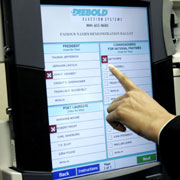Wednesday, August 16, 2006
Election Problems In Cleveland Probably Not Fixable By 2008

The county in Ohio which contains "the mistake on the lake" -- Cleveland -- has pervasive problems with their electronic voting technology, a new study says.
Problems with elections in Ohio's most populous county are so severe that it's unlikely they can be completely fixed by November, or even by the 2008 presidential election, a report commissioned by Cuyahoga County and released Tuesday says...
"The election system in its entirety exhibits shortcomings with extremely serious consequences, especially in the event of a close election," wrote Steven Hertzberg, director of the study by the San Francisco-based Election Science Institute.
Cuyahoga had some serious problems with the most recent primary, including:
Nearly 10 percent of Cuyahoga County's official ballots in the May 2 primary were "destroyed, blank, illegible, missing, taped together or otherwise compromised," according to experts who studied the county's new electronic voting system.
That could have made a recount impossible in a close race, says the report, which was released Tuesday.
Ohio law says that the official ballot in touch-screen voting machines is a paper receipt produced by and stored inside the machines. The paper record, similar to a cash register receipt, allows voters to verify that their votes are recorded accurately.
But even when the paper receipts were legible in the May 2 primary, more than three-quarters of them listed vote tallies that did not match the electronic record in the touch-screen machines...
(T)he new report shines a light on problems with the paper record in the Diebold Inc. touch-screen machines.
As part of the study, the firm examined the results from 467 machines in 50 polling locations. The consultants were unable to test 53 of the machines: 28 could not be found in the county warehouse, 24 had empty memory chips and one was broken. The paper records from 87 machines were missing.
In most of the other machines, the experts found discrepancies between the paper record and the electronic memory. To come up with its findings, the team compared the paper receipt to votes recorded on memory chips inside the machines as well as on removable memory cards.
In more than 75 percent of the machines examined, the paper record did not match the votes recorded on the memory chips or the memory cards. In more than a third of the machines, the difference was greater than 25 votes.
Most, if not all, of the problems identified in the report involve errors by workers. So much data has been lost that the consultants were unable to assess the accuracy of Diebold's touch-screen machines.


